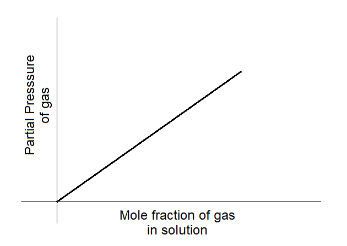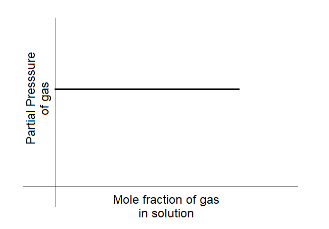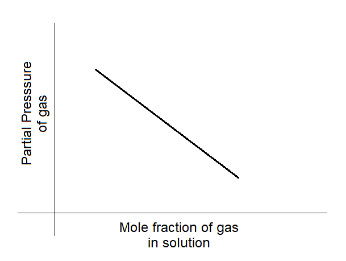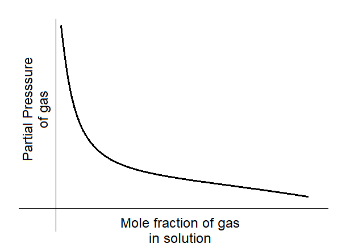
Which of the following curves represent Henry’s law?
A.
B.
C.
D.
Answer
221.7k+ views
Hint: Henry’s law comes under physical chemistry and it is denoted by Henry’s law constant. It is a type of gas law in which partial pressure of the gas and dissolution of gas is to be considered.
Formula used: Henry’s law is denoted by the given formula;
\[C = kP\] , where \[C\] represents the total concentration of dissolved gas in a liquid, \[k\] represents Henry’s law constant, and \[P\] denotes the partial pressure of the gas.
Complete Step by Step Solution:
Henry’s law was given by Sir William Henry. It is a type of gas law that states that the total amount of dissolved gas that is present in a liquid is directly proportional to the partial pressure of the gas above the liquid only when the temperature at which it occurs is kept constant.
Since Henry’s law is denoted as \[C = kP\] ;
Where \[C\] is the total amount of gas in the liquid and \[P\] represents partial pressure of the gas above the liquid, we can conclude that;
\[C \prec P\], hence if pressure increases, the total concentration of dissolved gas in a liquid will also increase.
If the partial pressure of the gas above the liquid is kept constant, the total amount of gas that is dissolved in the liquid will also be constant.
Hence, option A is the correct answer
Note: Henry’s law has its limitations and it is not applicable under certain conditions which are as follows
1. This law is only applicable when all of the molecules and partial pressure are under the state of equilibrium; if the equilibrium is damaged, this law fails.
2. The application of this law also fails to occur when the gases are under extreme pressure.
3. If the dissolved gas and the liquid have a chemical reaction with one another, this law fails.
Formula used: Henry’s law is denoted by the given formula;
\[C = kP\] , where \[C\] represents the total concentration of dissolved gas in a liquid, \[k\] represents Henry’s law constant, and \[P\] denotes the partial pressure of the gas.
Complete Step by Step Solution:
Henry’s law was given by Sir William Henry. It is a type of gas law that states that the total amount of dissolved gas that is present in a liquid is directly proportional to the partial pressure of the gas above the liquid only when the temperature at which it occurs is kept constant.
Since Henry’s law is denoted as \[C = kP\] ;
Where \[C\] is the total amount of gas in the liquid and \[P\] represents partial pressure of the gas above the liquid, we can conclude that;
\[C \prec P\], hence if pressure increases, the total concentration of dissolved gas in a liquid will also increase.
If the partial pressure of the gas above the liquid is kept constant, the total amount of gas that is dissolved in the liquid will also be constant.
Hence, option A is the correct answer
Note: Henry’s law has its limitations and it is not applicable under certain conditions which are as follows
1. This law is only applicable when all of the molecules and partial pressure are under the state of equilibrium; if the equilibrium is damaged, this law fails.
2. The application of this law also fails to occur when the gases are under extreme pressure.
3. If the dissolved gas and the liquid have a chemical reaction with one another, this law fails.
Recently Updated Pages
Types of Solutions in Chemistry: Explained Simply

States of Matter Chapter For JEE Main Chemistry

Know The Difference Between Fluid And Liquid

Difference Between Crystalline and Amorphous Solid: Table & Examples

Conduction Explained: Definition, Examples & Science for Students

Balancing of Redox Reactions - Important Concepts and Tips for JEE

Trending doubts
JEE Main 2026: Application Form Open, Exam Dates, Syllabus, Eligibility & Question Papers

Derivation of Equation of Trajectory Explained for Students

Hybridisation in Chemistry – Concept, Types & Applications

Understanding the Angle of Deviation in a Prism

How to Convert a Galvanometer into an Ammeter or Voltmeter

Degree of Dissociation: Meaning, Formula, Calculation & Uses

Other Pages
NCERT Solutions For Class 11 Chemistry Chapter 7 Redox Reaction

JEE Advanced Marks vs Ranks 2025: Understanding Category-wise Qualifying Marks and Previous Year Cut-offs

Hydrocarbons Class 11 Chemistry Chapter 9 CBSE Notes - 2025-26

Thermodynamics Class 11 Chemistry Chapter 5 CBSE Notes - 2025-26

NCERT Solutions ForClass 11 Chemistry Chapter Chapter 5 Thermodynamics

Equilibrium Class 11 Chemistry Chapter 6 CBSE Notes - 2025-26




